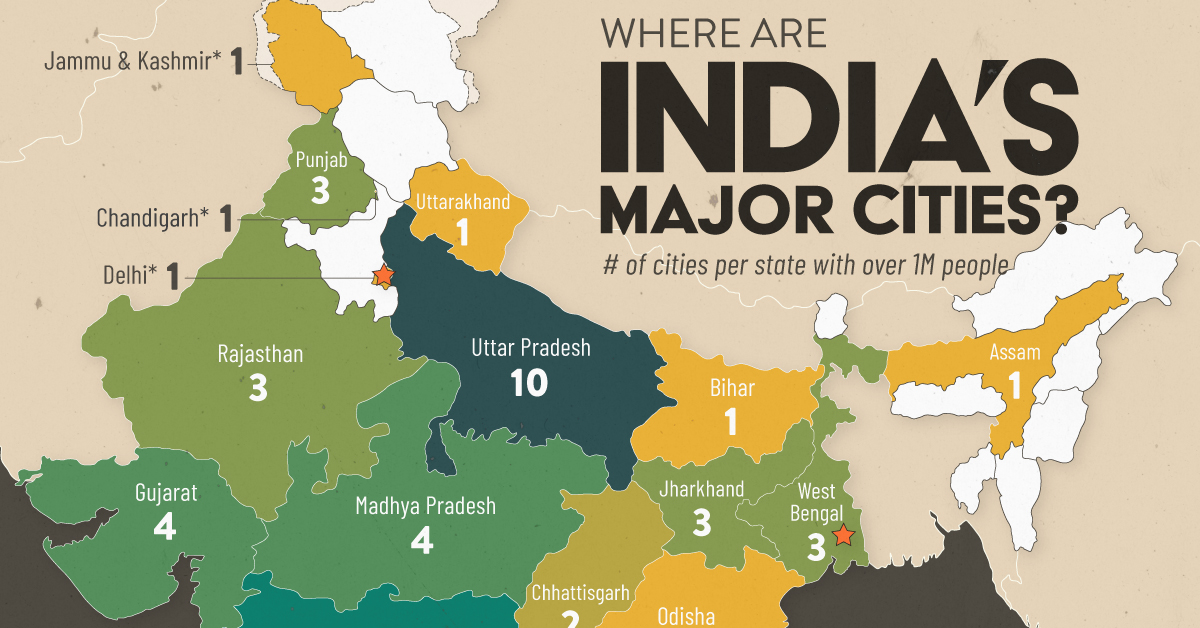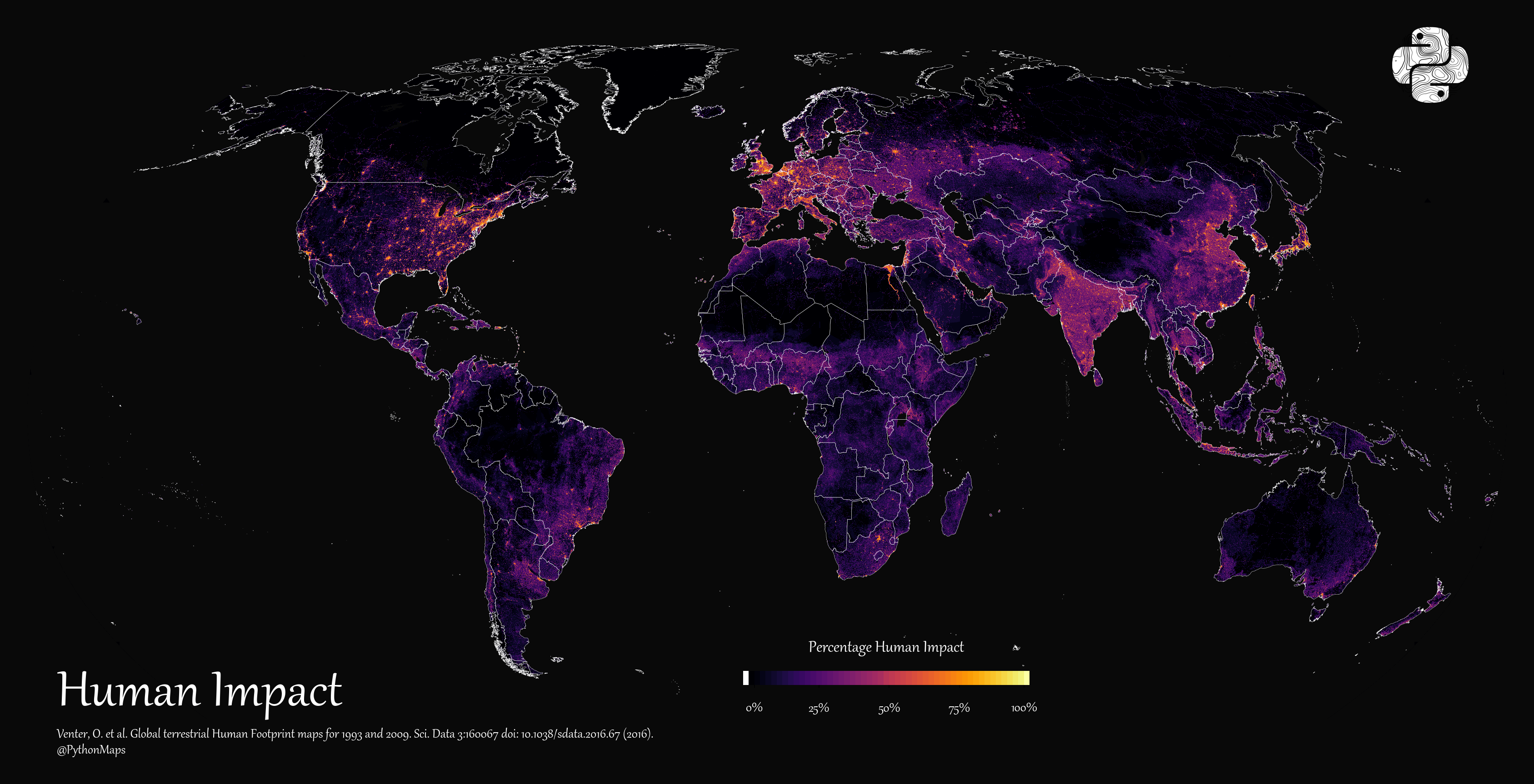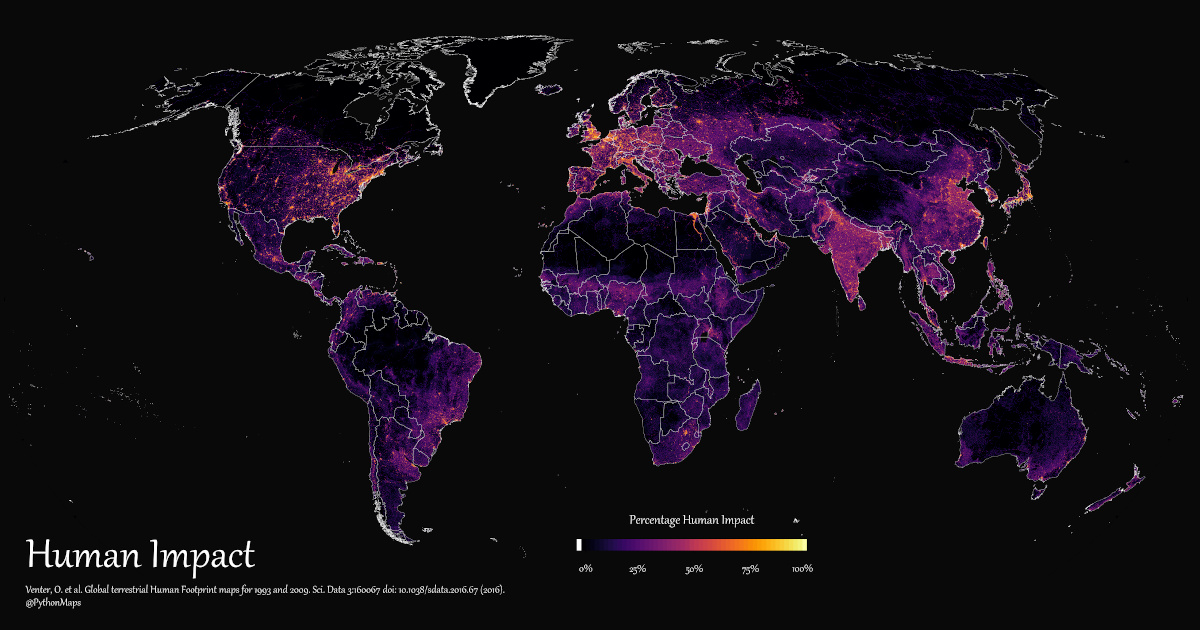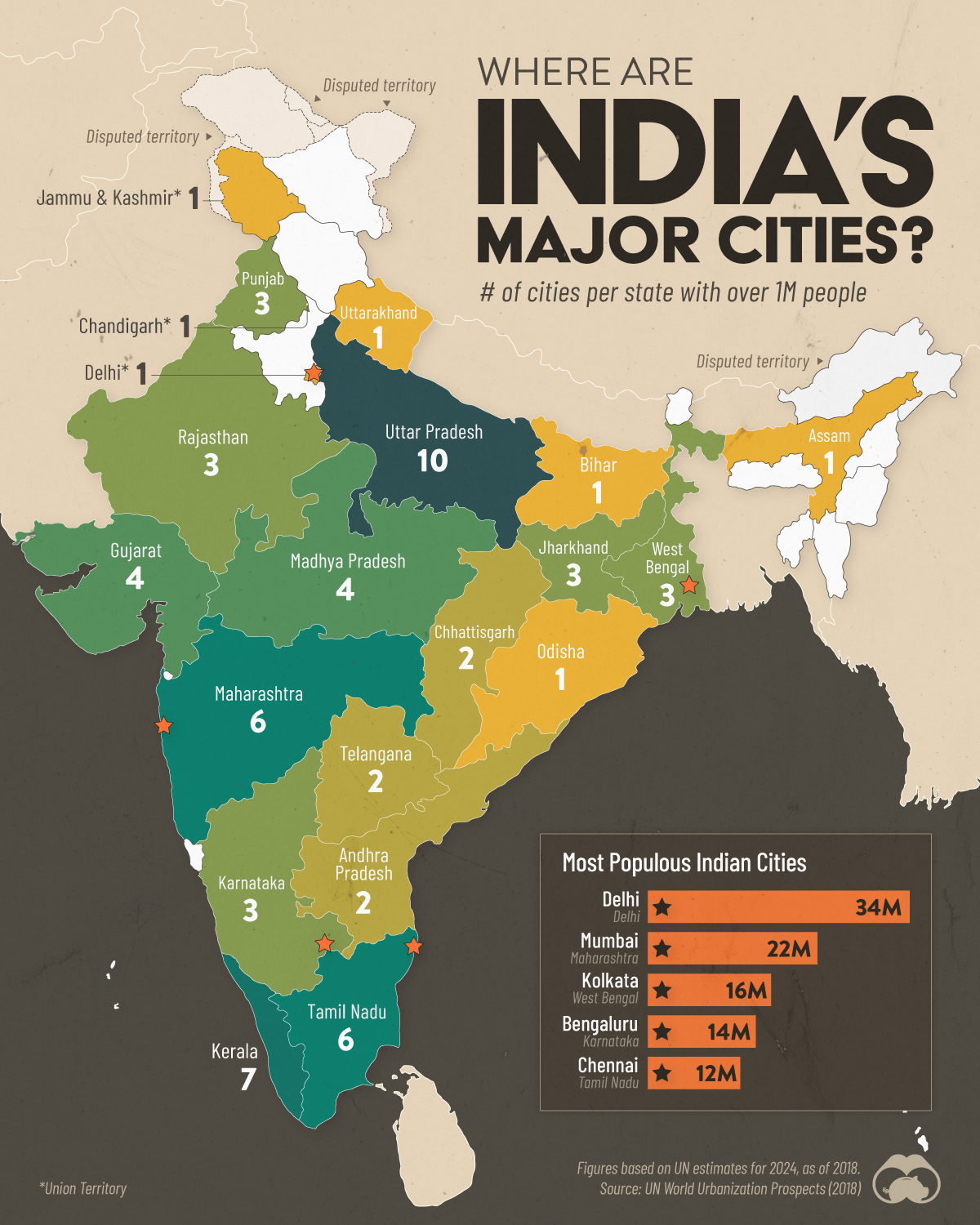population
Mapping Human Impact Across the World
Click to view this graphic in a higher-resolution.
Mapping Human Impact Across the World
Since the dawn of human history, our activities have left an impact on Earth—from gathering food to farming, from building homes and cities to traveling across oceans.
And as the global population expanded and civilizations became more complex, that impact grew alongside it. Mass agriculture, natural resource extraction, and creation of urban infrastructure are just some of the visible markers of modern human development.
In this graphic, Adam Symington maps the extent of humanity’s impact on the world from 1993 to 2009, using information provided by the scientific paper titled “Global Terrestrial Human Footprint Maps for 1993 and 2009.”
Variables for Measuring Human Impact
To accurately plot and measure human impact, the researches compiled studies and surveys from 1993 to 2009 across eight variables of human “pressure”:
- Built environments
- Population density
- Night-time lights
- Croplands
- Pasture
- Roads
- Railways
- Navigable waterways
- The Boston–Washington corridor (including New York City) in the U.S.
- The “Blue Banana” corridor in Europe from the UK to Northern Italy.
- The Nile Delta and Greater Cairo in Egypt.
- The Taiheiyō Belt in Japan (including Tokyo and Osaka).
These different pressures were then normalized and weighted, as some have a noticeably greater impact on the surrounding environments than others. Once plotted and overlayed, we can see where human impact was the highest.
What Caused the Largest Impact?
According to the research, increases in population density, housing development, and road and rail networks were the primary growth factors for human impact.
This caused the overall footprint to increase dramatically in densest urban centers of the world. The brightest and most visible on the map include:
Many other areas in South America, Central Africa, and South Asia, also saw human impact increase due to both increased urbanization and agriculture. Especially noticeable is the relatively even growth in human impact across Pakistan, India, and Bangladesh.
Untouched Wildernesses
While humanity’s footprint has transformed various parts of the world, some areas have been left untouched, to some extent.
The frigid Arctic terrains of Northern Canada, Greenland, Iceland, and Eastern Russia barely saw any change between 1993 and 2009.
Likewise, the Amazon rainforest in South America, the Sahara Desert in Africa, the Tibetan Plateau in Asia and the desert in Western Australia had large swaths of land with almost no human impact. However, they all had small patches of measured human impact, either through infrastructure development or resource extraction.
And though there were still corners of the Earth with little to no human impact in 2009, changes since in demographics, politics, and consumption could have an outsized effect on humanity’s footprint both now and into the future.

This article was published as a part of Visual Capitalist's Creator Program, which features data-driven visuals from some of our favorite Creators around the world.
Economy
Mapped: Indian States with Cities Over 1 Million People
Ten Indian states—most of them from the northeast region of the country—don’t have a single city with 1 million residents.

Mapped: Indian States with Cities Over 1 Million People
This was originally posted on our Voronoi app. Download the app for free on iOS or Android and discover incredible data-driven charts from a variety of trusted sources.
Slightly more than one-third of the 1.4 billion Indian population lives in an urban area. So where are the country’s most populous cities, and how are they spread across the country’s 28 states and eight union territories?
This map shows the number of Indian urban agglomerations (cities) with more than a million residents in each jurisdiction. Data for this graphic is sourced from 2024 urban agglomeration estimates in the UN World Urbanization Prospects.
Ranked: Indian States by Cities with 1M Residents
India’s Uttar Pradesh state has 10 cities with a population size of 1 million or more. It is also India’s most populous state, home to 240 million people. This makes it comparable to the size of Pakistan, the fifth most populous country in the world.
| Indian State | Cities with 1M Residents (2024) | City Names |
|---|---|---|
| Uttar Pradesh | 10 | Lucknow, Kanpur, Agra, Meerut, Varanasi, Prayagraj, Bareilly, Aligarh, Moradabad, Saharanpur |
| Kerala | 7 | Kozhikode, Malappuram, Thrissur, Kochi, Thiruvananthapura, Kannur, Kollam |
| Maharashtra | 6 | Mumbai, Pune, Nagpur, Nashik, Aurangabad, Solapur |
| Tamil Nadu | 6 | Chennai, Coimbatore, Madurai, Tiruppur, Tiruchirappalli, Salem |
| Gujarat | 4 | Ahmedabad, Surat, Vadodara, Rajkot |
| Madhya Pradesh | 4 | Indore, Bhopal, Jabalpur, Gwalior |
| Jharkhand | 3 | Jamshedpur, Ranchi, Dhanbad |
| Karnataka | 3 | Bengaluru, Mysore, Hubli-Dharwad |
| Punjab | 3 | Ludhiana, Amritsar, Jalandhar |
| Rajasthan | 3 | Jaipur, Jodhpur, Kota |
| West Bengal | 3 | Kolkata, Asansol, Siliguri |
| Andhra Pradesh | 2 | Visakhapatnam, Vijayawada |
| Chhattisgarh | 2 | Raipur, Durg-Bhilainagar |
| Telangana | 2 | Hyderabad, Warangal |
| Assam | 1 | Guwahati |
| Bihar | 1 | Patna |
| Odisha | 1 | Bhubaneswar |
| Uttarakhand | 1 | Dehradun |
| Chandigarh* | 1 | Chandigargh |
| Delhi* | 1 | New Delhi |
| Jammu & Kashmir* | 1 | Srinagar |
*Union Territories. Figures rounded. Some city names may have changed since this data was published.
Further south, Kerala (7), Maharashtra (6), and Tamil Nadu (6) also have more than five cities with a million or more people.
Meanwhile, some cities, including India’s national capital, New Delhi, are either in or are themselves union territories—areas directly administered by the central government.
Ten Indian states—most of them from the country’s northeast region—don’t have a single city with 1 million residents.
All together, India has 65 cities with more than one million inhabitants. For comparison, China has 105, and the U.S. has nine.
| Rank | City | State/Union Territory | 2024 Population Estimates |
|---|---|---|---|
| 1 | New Delhi | Delhi* | 34M |
| 2 | Mumbai | Maharashtra | 22M |
| 3 | Kolkata | West Bengal | 16M |
| 4 | Bengaluru | Karnataka | 14M |
| 5 | Chennai | Tamil Nadu | 12M |
| 6 | Hyderabad | Telangana | 11M |
| 7 | Ahmadabad | Gujarat | 9M |
| 8 | Surat | Gujarat | 8M |
| 9 | Pune | Maharashtra | 7M |
| 10 | Jaipur | Rajasthan | 4M |
| 11 | Kozhikode | Kerala | 4M |
| 12 | Malappuram | Kerala | 4M |
| 13 | Lucknow | Uttar Pradesh | 4M |
| 14 | Thrissur | Kerala | 4M |
| 15 | Kochi | Kerala | 4M |
| 16 | Indore | Madhya Pradesh | 3M |
| 17 | Kanpur | Uttar Pradesh | 3M |
| 18 | Nagpur | Maharashtra | 3M |
| 19 | Coimbatore | Tamil Nadu | 3M |
| 20 | Thiruvananthapuram | Kerala | 3M |
| 21 | Patna | Bihar | 3M |
| 22 | Bhopal | Madhya Pradesh | 3M |
| 23 | Agra | Uttar Pradesh | 3M |
| 24 | Kannur | Kerala | 2M |
| 25 | Visakhapatnam | Andhra Pradesh | 2M |
| 26 | Vadodara | Gujarat | 2M |
| 27 | Nashik | Maharashtra | 2M |
| 28 | Vijayawada | Andhra Pradesh | 2M |
| 29 | Kollam | Kerala | 2M |
| 30 | Rajkot | Gujarat | 2M |
| 31 | Ludhiana | Punjab | 2M |
| 32 | Madurai | Tamil Nadu | 2M |
| 33 | Raipur | Chhattisgarh | 2M |
| 34 | Meerut | Uttar Pradesh | 2M |
| 35 | Varanasi | Uttar Pradesh | 2M |
| 36 | Srinagar | Jammu & Kashmir* | 2M |
| 37 | Tiruppur | Tamil Nadu | 2M |
| 38 | Jamshedpur | Jharkhand | 2M |
| 39 | Aurangabad | Maharashtra | 2M |
| 40 | Jodhpur | Rajasthan | 2M |
| 41 | Ranchi | Jharkhand | 2M |
| 42 | Kota | Rajasthan | 2M |
| 43 | Jabalpur | Madhya Pradesh | 2M |
| 44 | Asansol | West Bengal | 2M |
| 45 | Gwalior | Madhya Pradesh | 2M |
| 46 | Allahabad | Uttar Pradesh | 2M |
| 47 | Amritsar | Punjab | 1M |
| 48 | Dhanbad | Jharkhand | 1M |
| 49 | Bareilly | Uttar Pradesh | 1M |
| 50 | Aligarh | Uttar Pradesh | 1M |
| 51 | Moradabad | Uttar Pradesh | 1M |
| 52 | Mysore | Karnataka | 1M |
| 53 | Durg-Bhilainagar | Chhattisgarh | 1M |
| 54 | Bhubaneswar | Odisha | 1M |
| 55 | Tiruchirappalli | Tamil Nadu | 1M |
| 56 | Chandigarh | Chandigarh* | 1M |
| 57 | Saharanpur | Uttar Pradesh | 1M |
| 58 | Hubli-Dharwad | Karnataka | 1M |
| 59 | Guwahati | Assam | 1M |
| 60 | Salem | Tamil Nadu | 1M |
| 61 | Siliguri | West Bengal | 1M |
| 62 | Jalandhar | Punjab | 1M |
| 63 | Solapur | Maharashtra | 1M |
| 64 | Warangal | Telangana | 1M |
| 65 | Dehradun | Uttarakhand | 1M |
*Union Territories. Figures rounded. Some city names may have changed since this data was published.
Interestingly, three of the five most populous Indian cities (Mumbai, Kolkata, and Chennai) were villages that became key British trading outposts. As a result all three cities have a fort within their city limits which acted as protection against competing colonial interests at the time.
Finally, Uttar Pradesh—which leads the states by number of cities with 1M people—doesn’t have a single metropolis within the top 10.
-

 Healthcare2 weeks ago
Healthcare2 weeks agoWhich Countries Have the Highest Infant Mortality Rates?
-

 Misc1 week ago
Misc1 week agoVisualizing Global Losses from Financial Scams
-

 population1 week ago
population1 week agoMapped: U.S. States By Number of Cities Over 250,000 Residents
-

 Culture1 week ago
Culture1 week agoCharted: How the Logos of Select Fashion Brands Have Evolved
-

 United States1 week ago
United States1 week agoMapped: Countries Where Recreational Cannabis is Legal
-

 Misc1 week ago
Misc1 week agoVisualized: Aircraft Carriers by Country
-

 Culture1 week ago
Culture1 week agoHow Popular Snack Brand Logos Have Changed
-

 Mining2 weeks ago
Mining2 weeks agoVisualizing Copper Production by Country in 2023














